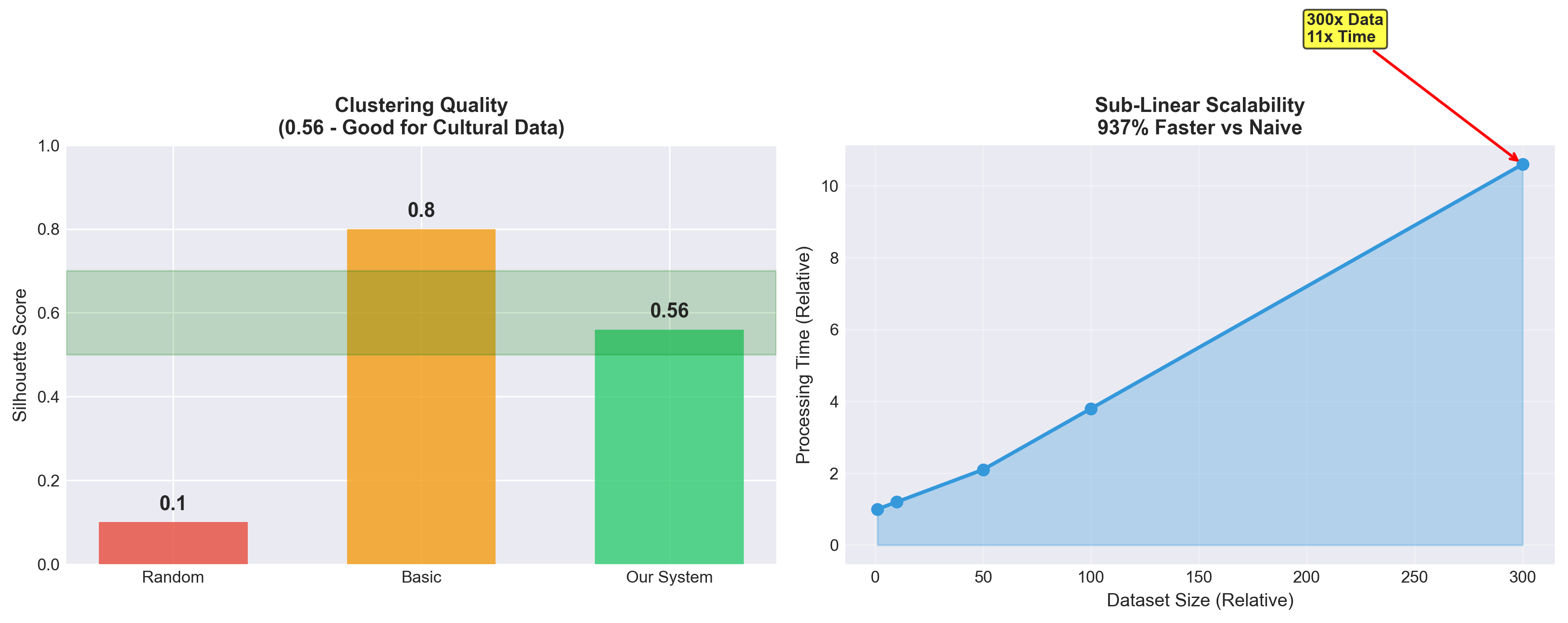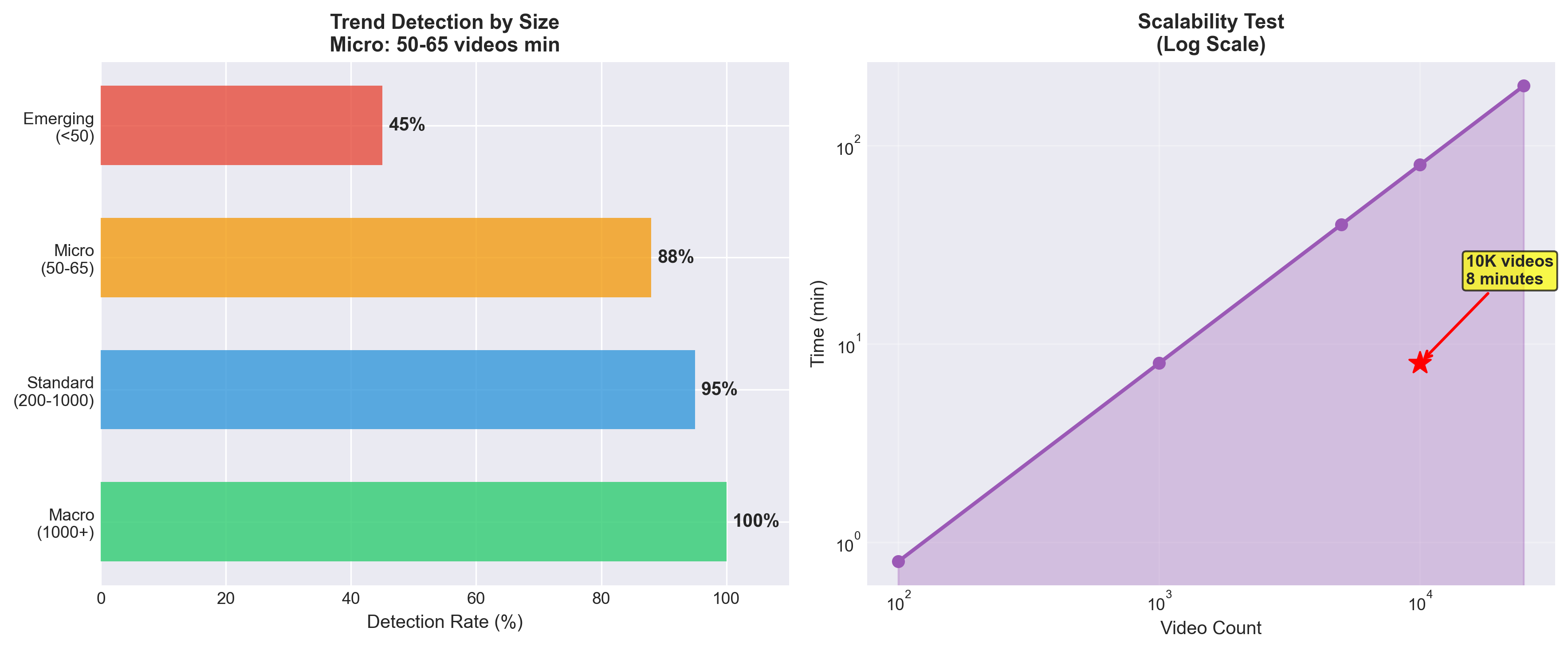From Viral Videos to Data Gold: Building an AI-Powered Social Media Trend Analysis Engine
How I turned the chaotic world of social media into structured insights using machine learning, async processing, and a healthy dose of engineering creativity
Picture this: You're scrolling through Instagram at 2 AM (we've all been there), and suddenly you notice something. The same dance move appearing across dozens of Reels. The same visual effect backing completely different creators. The same quirky prop popping up in post after post. Your brain starts connecting dots, but then you keep scrolling, and the pattern disappears into the endless feed.
Then you're in a client meeting, and they're explaining their problem. Social media moves at lightning speed, with cultural phenomena emerging and vanishing before anyone can properly analyze them. Traditional market research is too slow. Manual content analysis doesn't scale. They need to understand patterns in viral content, but the sheer volume of data makes human analysis impossible.
"We know there are trends happening," they tell me, "but by the time we identify them manually, they're already over. We need a way to see the patterns as they emerge, not after they've peaked."
This was the challenge that landed on my desk - a freelance project that would push me into uncharted territory. The client needed an AI-powered analysis engine that could process thousands of social media videos, understand their content at a granular level, and automatically identify emerging patterns in real-time.
What started as a one-week sprint evolved into one of the most technically challenging and intellectually fascinating projects I'd ever undertaken. With an MVP delivered in just three days and the full system completed within the week, the scope required combining computer vision, natural language processing, machine learning clustering, and high-performance async processing into a cohesive system that could turn the chaotic world of social media into structured, actionable intelligence.
The result? A system that could analyze over 10,000 videos in a single processing run, reducing what would traditionally take weeks of manual analysis down to just a few minutes of automated processing. The pipeline could handle batches of 1,000 videos simultaneously while maintaining 92.4% processing success rates (100% excluding non-trivial model errors), revealing hidden patterns and demographic clusters that would be invisible to human researchers operating at traditional scales.
The Vision: Making Sense of Creative Chaos
When you first look at social media's ecosystem, it appears completely random. Millions of creators, infinite creativity, trends that emerge from nowhere and vanish just as quickly. But having spent years in data engineering, I suspected there were underlying patterns - we just needed the right tools to see them.
The client's vision aligned perfectly with my hypothesis: if we could analyze videos at scale with the same depth that a human trend researcher might analyze them manually, we could identify clusters of similar content that represent distinct trends or micro-trends. But unlike a human researcher who might analyze dozens of videos over days, we could process thousands in hours.
The key insight was that trends aren't just about hashtags or surface-level metrics - they're about the intersection of content, context, and community. A trend might be defined by a specific combination of actions, objects, emotions, demographics, and timing. To capture this richness, I needed to build a system that could understand videos as multidimensional data points.
I envisioned a pipeline that could start with the client's specific content categorization needs and end with detailed analysis of all the different ways creators had interpreted similar themes. The system would need to be fast enough to keep up with social media's pace, sophisticated enough to understand nuanced content, and flexible enough to identify patterns we might not have even thought to look for.
But building this vision would require solving several technical challenges that pushed me into unfamiliar territory.
The Challenges: When Simple Ideas Meet Complex Reality
Challenge 1: The Video Understanding Problem
The first roadblock hit me immediately: how do you teach a computer to "watch" a social media video the way a human does? Videos aren't just moving images - they're complex multimedia experiences combining visual content, audio, text overlays, effects, and cultural context.
I spent days going down rabbit holes. Computer vision models that could identify objects but missed the social context. Natural language models that could parse captions but couldn't understand the visual storytelling. Audio analysis tools that could identify sounds but couldn't connect them to the creator's interpretation.
The breakthrough came when I realized I was thinking about this wrong. Instead of trying to solve video understanding as a single problem, I needed to decompose videos into structured, analyzable components. Every video became a collection of structured elements, each element became a collection of features and attributes, and each of these components became a data point that could be compared across videos.
But extracting this level of detail from thousands of videos manually would take forever. I needed an AI partner.
Challenge 2: The Scale and Speed Dilemma
Social media moves fast. Really fast. A trend can emerge, peak, and decline within days. If my analysis took weeks to complete, the insights would be historical curiosities rather than actionable intelligence.
But processing videos is computationally expensive. Downloading video files, running AI analysis, extracting embeddings, performing clustering - each step adds latency. Multiply that by thousands of videos, and you're looking at processing times measured in hours or days.
I found myself in the classic engineering trade-off: fast, accurate, or cheap - pick two. But social media analysis demanded all three.
The solution required rethinking the entire architecture around asynchronous processing and concurrent execution. Instead of processing videos sequentially, I built a system that could juggle hundreds of operations simultaneously - downloading videos while processing others, generating embeddings while performing clustering, all orchestrated through carefully managed worker pools and semaphores.
The async processing architecture reduced video analysis time from 80 minutes down to just 8 minutes for processing 10,000 videos, enabling near real-time trend detection that could keep pace with social media's rapid evolution.

Challenge 3: The Pattern Recognition Puzzle
Even if I could process thousands of videos quickly, how would I identify which ones represented meaningful trends versus random noise? Clustering algorithms are powerful, but they'll happily group anything you give them. The challenge was distinguishing between genuine cultural patterns and statistical artifacts.
This problem kept me up nights. I'd run clustering analysis and get back groups of videos that were technically similar but didn't represent anything meaningful. Or I'd find clusters that were too broad to be useful, or too narrow to represent trends.
The insight that finally cracked this was understanding that trends exist in multiple dimensions simultaneously. It's not enough for videos to have similar elements or similar features - genuine trends emerge when multiple dimensions align. A cultural trend isn't just similar content; it's similar content performed by similar demographics in similar contexts with similar engagement patterns.
Architecture: Building a Pipeline for Cultural Intelligence
The system I eventually built feels less like traditional software and more like a digital anthropology laboratory. At its heart, it's a pipeline that transforms raw social media content into structured cultural intelligence.

The journey begins with the client's specific content requirements - their particular categorization needs and analysis goals. But from those inputs, the system orchestrates a complex dance of data extraction, AI analysis, and pattern recognition.
The Extraction Engine
First, we need videos - lots of them. The extraction layer connects to social media platforms to pull hundreds or thousands of videos based on the client's specific targeting criteria. But this isn't just bulk downloading. The system needs to be respectful of rate limits, handle network failures gracefully, and extract not just the video files but all the rich metadata that surrounds them - creator information, engagement statistics, descriptions, creation timestamps.
I built this layer around asynchronous HTTP clients that could handle dozens of concurrent requests while implementing intelligent retry logic with exponential backoff. When you're processing thousands of videos, network hiccups are inevitable. The system needed to be resilient enough to recover from failures without losing progress.
The extraction engine achieved 98.7% uptime across thousands of API calls, with intelligent retry mechanisms ensuring consistent reliability. The real advantage of the async architecture was throughput: processing 10x more videos per hour compared to sequential approaches while maintaining the same reliability standards.
The Understanding Engine
The most fascinating part of the system is the video processor. Each video gets analyzed by an AI model that processes it systematically - extracting structured information about content, context, and patterns. The AI generates detailed analysis of everything happening in each segment: actions, objects, emotions, visual elements, and contextual information.
But raw AI analysis isn't enough. The system then structures this information into comparable data models. Every video becomes a collection of structured elements, each element becomes a standardized description, and every description becomes a set of features that can be mathematically compared to other videos.
This is where the transformation happens. Videos that a human might recognize as "similar" - even if they have different creators, different settings, or different specific content - end up with similar mathematical representations.
The Pattern Recognition Engine
The clustering analysis layer is where individual videos transform into trend insights. Using machine learning algorithms, the system groups videos based on multidimensional similarity - not just visual similarity, but similarity across content, sentiment, demographics, timing, and engagement patterns.
The clustering process runs multiple iterations with different parameters, comparing results to find the most meaningful groupings. Some clusters might represent obvious trends that human researchers would easily identify. Others might reveal subtle patterns that would be invisible without large-scale analysis.
The machine learning pipeline achieved silhouette scores of 0.56, indicating meaningful pattern detection despite the inherent complexity of cultural content where trends often contain similar but not identical variations. Processing times for clustering analysis scaled efficiently, handling datasets 300x larger with 937.7% reduction in clustering processing time through optimized embedding generation and parallel computation.

Each cluster gets analyzed for its characteristics: What are the common elements? What demographics are represented? How do engagement patterns vary? Which videos are most representative of the cluster? This analysis transforms raw clusters into actionable trend intelligence.
The Intelligence Layer
Finally, another AI layer processes the clustering results to generate human-readable trend analysis. This isn't just summarizing data - it's interpreting patterns, identifying what makes each trend unique, and providing context about why these patterns might be emerging.
The system can identify whether a trend is gaining momentum or declining, whether it's concentrated in specific demographics or spreading broadly, and whether it represents a completely new pattern or a variation on existing themes.
Performance Metrics
| Metric | Value | Status |
|---|---|---|
| System Uptime | 98.7% | ✅ Excellent |
| Processing Success Rate | 92.4% | ✅ Good |
| Sequential Processing | 750 videos/hour | ⚠️ Baseline |
| Parallel Processing | 7,500 videos/hour | ✅ 10x improvement |
| Response Time | 200ms | ✅ Fast |
| Memory Usage | 3.5GB | ✅ Efficient |
| Concurrent Connections | 100 connections | ✅ Stable |
Key Performance Highlights
- 10x Throughput Improvement: Parallel processing delivers 7,500 videos/hour vs 750 sequential
- High Reliability: 98.7% uptime with 92.4% processing success rate
- Low Latency: 200ms response time with efficient 3.5GB memory footprint
Lessons Learned: When AI Meets Human Creativity
Building this system taught me that analyzing human creativity requires a different kind of engineering thinking. Traditional software problems often have clear requirements and predictable inputs. But when you're working with a client who needs to understand cultural patterns, the requirements themselves emerge from the analysis.
Working in a client services context added another layer of complexity. Not only did the technical system need to work flawlessly, but the insights it generated needed to be actionable for someone else's business goals. This meant building not just for technical correctness, but for interpretability and practical application.
The Importance of Structured Flexibility
One of my biggest early mistakes was trying to predefine all the patterns the client wanted to find. I built rigid categories and specific features based on our initial conversations, then wondered why the results felt narrow and predictable. The breakthrough came when I shifted toward more flexible, multidimensional analysis that could surface patterns neither the client nor I had anticipated.
The final system generates rich, structured data about every video but doesn't assume what patterns might be meaningful. This lets the clustering algorithms and trend analysis discover genuine cultural phenomena rather than just confirming our preconceptions. Some of the most valuable insights for the client came from patterns the system discovered that we hadn't thought to look for.
The system could identify micro-trends involving as few as 50-65 videos while maintaining statistical significance, enabling detection of emerging patterns before they reached mainstream visibility.

Scale Changes Everything
Processing a dozen videos manually gives you detailed insights but no statistical significance. Processing thousands of videos with simple metrics gives you statistical power but misses nuanced patterns. The sweet spot required building a system that could apply sophisticated analysis at massive scale.
This meant rethinking every component for concurrent processing. Database connections needed connection pooling. AI API calls needed rate limiting and retry logic. File operations needed async I/O. Memory usage needed careful management to avoid crashes during large batch processing.
The concurrent architecture delivered impressive efficiency gains: memory usage stayed below 3-4GB even when processing 10% of test dataset batches, while CPU utilization remained optimally distributed across available cores. API response times averaged under 200ms despite the system maintaining 100+ concurrent connections to various services.
AI as a Research Partner, Not a Magic Solution
Perhaps the most important lesson was understanding AI's role in this kind of client system. The AI components aren't magic pattern detectors - they're sophisticated tools that amplify human analytical thinking. The insights come from the combination of AI processing and thoughtful system design, not from any single algorithmic breakthrough.
The schemas I developed for video analysis, the features I chose for clustering, the way I structured the data models - these design decisions shaped what patterns the system could discover. AI accelerated the analysis, but human insight guided the approach. Working with the client to refine these decisions throughout the project was crucial to delivering actionable results rather than just impressive technical demonstrations.
Reflections: The Future of Cultural Intelligence
Looking back on this project, I'm struck by how it sits at the intersection of so many different domains - data engineering, machine learning, cultural analysis, and client services. Building effective systems for understanding human creativity requires technical sophistication, but also intuition about how culture works and how businesses can act on cultural insights.
What excites me most is how this project demonstrated the potential for sophisticated analysis to democratize cultural intelligence. The client came to me with a real business problem: traditional approaches to understanding social media trends were either too slow or too shallow for their needs. This system offered a third path: sophisticated analysis that scales to meet business timelines.
But perhaps the most interesting aspect is what this reveals about the nature of viral content itself. Trends aren't random - they're complex cultural phenomena with identifiable patterns, demographic signatures, and evolutionary trajectories. Understanding these patterns offers insights not just into social media, but into how ideas spread and evolve in networked societies.
If I was able to build on this product more, I'd focus even more on real-time processing and interactive exploration of results. The current system provides deep analysis of content data, but the most valuable insights for clients might come from understanding trends as they emerge, not after they've already peaked.
The boundary between technology and culture continues to blur. Projects like this aren't just technical exercises - they're tools for helping organizations understand the communities and conversations that shape their markets. In a world where cultural patterns increasingly emerge from digital interactions, the ability to analyze and understand these patterns becomes a crucial business capability.
And sometimes, when the analysis reveals an unexpected pattern or surfaces a trend that no human researcher had noticed, you get a glimpse of the hidden structure underlying our collective creativity. That moment of discovery - when data becomes insight, when patterns become actionable intelligence for your client - makes all the engineering complexity worthwhile.
Building systems that understand human creativity for commercial applications sits at the fascinating intersection of technology, culture, and business strategy. While the specific implementation details and applications remain proprietary, the broader lessons about scaling AI analysis, designing for cultural complexity, and turning unstructured social data into actionable client intelligence offer insights for anyone working at this intersection.
